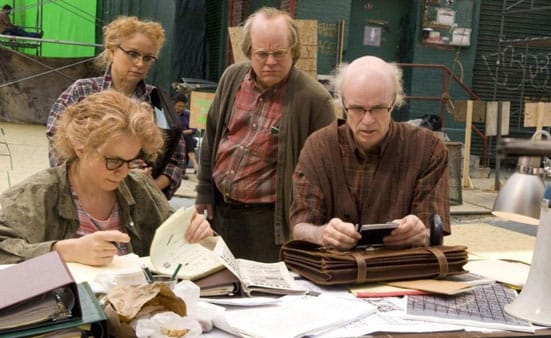Caden Cotard, the protagonist in Charlie Kaufman's new film, 'Synecdoche, New York', is dying in the most appalling, piecemeal way. His ailments aren't terminal in themselves, but they are unabating in their almost slapstick wretchedness: Unsightly, sycotic pustules break out on his face; varicose veins bulge from his legs and arms; a seizure leaves him unable to "cry, salivate etc."; he requires brutal, bloody gum surgery; his stools are either spotted with blood, jet black or ash grey; his urine is a worrying dark, rusty colour; his pupils don't "open and close properly"; and, one day, his right leg won't stop convulsing. These inflictions – that spring adversarially from that terrible, dark red interior – punctuate and parallel the events of Caden's life, undermining his dignity and wresting control from him in so many of the relationships in his life. Other people find his absurdly constant illnesses tedious, exhausting and not a little repulsive – as if they are his fault. As if his tedious, exhausting and not a little repulsive neuroses are made manifest on the surface of his body. As if his innate guilt were writ large in boils and abscesses. In the world of 'Synecdoche' the boundary between the mental and the physical, between neuroses and illness, paranoia and accident, desire and nightmare – is paper-thin. More often than not they rhyme with fatalistic clarity. The end is built in to the beginning. The object of Caden's desire, Hazel, goes to look at a prospective home that is continuously burning – flames lick the windows, smoke billows from under the doors. While talking with the estate agent, she expresses her sole reservation: she's afraid of dying in the fire. The symbolism seems clear, particularly if we are to understand that Caden is the fountainhead for this dream-logic (the house burns with Caden's desire for Hazel, which, like fire, destroys what it touches etc.), but the coarser, physical consequences of living in a burning building are also described. Smoke inhalation as the effect of a smoldering affair.
Caden's illnesses too seem to enact the films psychological tropes: the seizure that leaves him unable to cry or salivate deliberately retards Caden's emotional expression, forcing him to preface weeping with a couple of squirts of bottled tears; to eat soup with a disgusting, pelican-like chug of the head and a desperate "expression" of saliva. He is dehumanised by these ailments, made mortal through a rough return from healthy, blissfully ignorant control to all-consuming incontinence. This parity between ignorance, and health and happiness, is a familiar theme in Kaufman's films. Self-knowledge and social awareness are ever more bodily, which is ever more centred on individual culpability. Reading his estranged daughter's diary, the equivalence between his bad breath and hulking frame, and her loathing for him, is explicit. A person's humanity, at least in post-industrial countries, seems contingent upon the health of their body.
–
Rosi Braidotti, in her book 'Metamorphoses', cites Jackie Stacey's description of a contemporary perversion of Foucault's theme of bio-power. The emphasis has shifted to "a form of hyper-individualism which places the responsibility for one's well-being squarely into one's own hands. Illness today is related to 'self-management'". The interconnectedness of Caden's illnesses with social anxiety made manifest, relates to Braidotti's "enfleshed subject": the construction of subjectivity through the body – through sexuality and through visitations of violence and illness – in a contemporary scenario. Caden's perpetual illness symbolises his inability to manage himself, to be a coherent subject.
_
Caden's response to this failure, though not immediate, provides the ideological corrective to this 'self-management', and also the most prominent fantasy of the film: the management – the direction – of everyone and everything. Caden's play within the film is his attempt to be true to both himself and to that uncaring and doomed life; to unflinchingly represent everything as it really is, without the devices and strategies (narrative, exegesis, resolution, poeticism etc.) that lie and lie in drama. Nothing ends but in death, particularly not his play. With a cast of thousands each playing another actor within the film and on and on; an impossibly large hangar as the theatre somewhere in New York; a rehearsal period that stretches on for years; and a set that is a perfect simulacrum of Caden's entire geography. The play looms larger than life, truer than life. But as Caden's physical and psychical coherence slips away, so his identity enters a state of reflexive flux – a kind of looping feedback – under the auspices of the play. In his pursuit of truth, Caden arrives at its flickering, symmetrical heart: a tautology. The incomprehensible, unreasonable collapse of Caden's body is the only inviolable and terrible certainty. The end is built in to the beginning.
–
Losing control of his body, it betrays him, finally revealing it's autonomy that was always there; it's ulterior, adulterous abandonment from invisible allied existence; suddenly displayed, and so disgracefully. Like an inversion, a turning inside out. It's only when his body breaks down into spasms and emissions does it reveal its unknowably complex workings – that dark red interior (pitch black without incision) – irreversibly spilled and inscrutable on the floor.
–
*The Cotard delusion or Cotard's syndrome, also known as nihilistic or negation delusion, is a rare neuropsychiatric disorder in which a person holds a delusional belief that he or she is dead, does not exist, is putrefying or has lost his/her blood or internal organs. Rarely, it can include delusions of immortality. (http://en.wikipedia.org/wiki/Cotard_delusion)
Ed Atkins

'Caden and Hazel with their understudies'